- SOM
- Departments and Offices
- SOM Departments
- Surgery
- Residents
- Resources
- About Surgery at UMMC
About Surgery at UMMC
- Department of Surgery Home
- About Us
- Faculty and Divisions
- Residents
- Fellows
William A. Neely Library
On Oct. 5, 2001, the Department of Surgery dedicated the William A. Neely Library, located on the first floor of the University Hospital. Dr. William W. Turner Jr., the James D. Hardy Professor and chairman of the Department of Surgery, paid tribute to Dr. Neely. Attending the dedication ceremony were Dr. Daniel Jones, Associate Vice Chancellor for Health Affairs of the University of Mississippi Medical Center; Dr. James D. Hardy, the founding chair of the Department of Surgery; former colleagues of Dr. Neely; and current faculty, residents and students.
Dedication ceremony
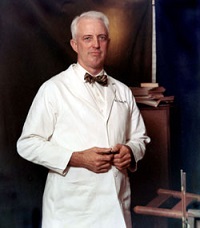 The following is a transcript of Dr. Turner's remarks:
The following is a transcript of Dr. Turner's remarks:
"Welcome to the dedication of this library that bears the name of Dr. William Augustus Neely, one of the original faculty members in our department of surgery. I am fascinated by what makes an individual memorable. Today we begin the process of remembering 'Gus' Neely. We return that memory to where it lived for so many years in the department of surgery.
I want to recognize the Neely family who has joined us for this celebration. Anne and Gus Neely were married on Jan. 1, 1947, and they were together for 38 years until Dr. Neely's death. Anne, you honor us with your presence, and I hope that this library will be the special place for you that it will become for us. Mary Anne Neely Young, the first daughter, and her husband, Robert, live in Houston. William A. Neely, Jr., 'Bubba,' and his wife, Paula, live in Madison. Florence Neely Cooper and her husband, Walter, live in Jackson. Dr. Iley Neely and her husband, Robert Miles, live in Ft. Lauderdale. Please accept this library on behalf of your dad, and recognize that it will be a place used by students, residents and faculty to become better doctors.
I want to recognize the heart and soul of the Department of Surgery, Dr. James D. Hardy. During a recent visit with Dr. Hardy, I was reviewing activities in the department, and I mentioned that we were dedicating this library to Gus Neely, making sure that Dr. Hardy had received an invitation and not expecting him to be able to attend. In that 'Hardy way' that we know so well, Dr. Hardy responded immediately, 'I'll be there. I owe it to Gus.'
I want to recognize the University Hospital executive administrative staff, represented by Ted Woodrell, the Associate Vice Chancellor for Integrated Health Systems and Director of the University Hospitals and Clinics, and Mark Wall, administrator of the University Hospital. The University Hospital built this facility. Ted and Mark, the Department of Surgery and the Neely family are very grateful to you.
I want to recognize the Associate Vice Chancellor for Health Affairs, Dr. Dan Jones, here representing Dr. Wallace Conerly and, of course, himself, for the unflagging support that you have given to the Department of Surgery in its quest to reconnect to our history and to provide the best environment to learn surgery.
Ron Horne is the new acting director of the Physical Facilities Division of the University Medical Center. Ron has provided tremendous help to us in building this facility. Ron, we want to thank you and all of your staff.
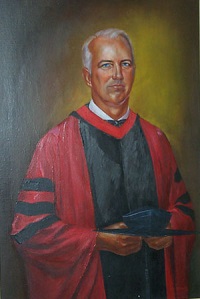 I want to recognize the special projects coordinator in the Department of Surgery, Irene Cooper, who has steered the Neely Library to completion with dedication and compulsiveness. Irene, we could not have gotten here without you.
I want to recognize the special projects coordinator in the Department of Surgery, Irene Cooper, who has steered the Neely Library to completion with dedication and compulsiveness. Irene, we could not have gotten here without you.
A number of months ago, I asked Anne Neely to preview this library while it was still under construction. It was an emotional occasion. During the visit, I asked her if there were pictures of Dr. Neely that we might get reproduced to hang in the library. Shortly thereafter, she invited me to her house to look at some photos of Gus Neely. Some of those now hang in the library. Anne told me that she had something that she and her family wanted to present to the library. The Neelys have presented the library with the magnificent portrait of Dr. Neely that hangs on the wall. He is posed in the crimson robes of his alma mater, Harvard. Eric McDonald, who at the time of the portrait was working as a medical illustrator in the Department of Surgery, painted it. Anne, Mary Anne, Florence, Bubba and Iley, this department thanks you from the bottom of our hearts for your gift that has put Gus back with us.
Early years
Gus Neely was born in Memphis, June 10, 1921. He grew up in Banks, Miss., in the Delta, south of Memphis. His father, Augustus Neely, was a farmer who lived through the great depression. Both his mother, Mary Gatewood Neely, and his father had strong values in regard to education. Mrs. Neely graduated from the University School in Oxford as the only girl in her class, and she became a schoolteacher. Mr. Neely's intelligence far exceeded his formal education. Gus Neely graduated from Tunica County High School in 1938. He went to college at Ole Miss where he graduated in 1942 with a degree in mathematics.
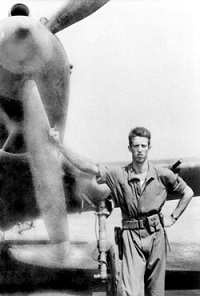 He was a member of the Ole Miss 'Flying Rebels' ROTC squadron. Flying became a lifelong passion for Gus. Upon graduation, he was commissioned into the Army Infantry, but he soon transferred to the Army Air Corps, the predecessor of the modern Air Force. Gus was stationed in Panama during World War II. We have wonderful pictures of Gus during this period hanging in the library. In 1947, Gus left active duty.
He was a member of the Ole Miss 'Flying Rebels' ROTC squadron. Flying became a lifelong passion for Gus. Upon graduation, he was commissioned into the Army Infantry, but he soon transferred to the Army Air Corps, the predecessor of the modern Air Force. Gus was stationed in Panama during World War II. We have wonderful pictures of Gus during this period hanging in the library. In 1947, Gus left active duty.
Anne Neely's brother, Clarence Morgan, and Gus Neely graduated from Ole Miss together. At the time Anne didn't know Gus. She would meet him after the conclusion of World War II. Anne and Gus Neely were married Jan. 1, 1947, during a sleeting storm in Kosciusko, Anne's hometown. Gus Neely entered the two-year medical school at Ole Miss. On the advice of Dr. Arthur Guyton, Gus applied to and was accepted at Harvard Medical School, where he graduated in 1951.
Gus completed his internship at Barnes Hospital in St. Louis. From there he went to the University of Tennessee at Memphis for surgical residency under Dr. Harwell Wilson. In Memphis Gus was a research fellow with Dr. Hardy who had come to Memphis out of his residency at the University of Pennsylvania. In 1955, Dr. Hardy brought Gus Neely to Jackson to be his chief resident along with Dr. Robert Caldwell. Dr. Hardy told me why Gus was such a good candidate to be his first chief resident. He said, 'Gus was an only child, raised on a plantation with a cotton gin, who could do a little of everything. He was "almost brilliant.'' ' What perfect characteristics for a chief resident in surgery!
Gus and Anne Neely had three children by the time that they moved to Jackson on July 4, 1955. The fourth daughter, Leigh, would be born here.
Gus Neely was a chief resident from 1955-1957, and he joined the faculty in the Department of Surgery following completion of his residency. At our fledgling medical school, Gus Neely established the trauma service (then known as the emergency room service) at the University Hospital, and he directed the general thoracic surgical service. He established a research laboratory. In 1959, he became an assistant professor with appointments in surgery, biochemistry and physiology. He became an associate professor in 1962 and a professor in 1973.
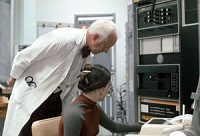 Gus Neely's first publication, entitled 'Fluid Kinetics Following Thermal Burns in Man,' appeared in the journal Surgery in 1953. It was co-authored with Drs. Hardy and Wilson. He published a total of 88 articles, the last with Dr. Angel Markov entitled 'An Analogue to Digital Converter Patch for Microware System Clock Module.' Included were publications dealing with burns, fluid and electrolyte physiology, trauma, tissue blood flow measurement, and asanguineous total body perfusion. Gus Neely is one of the authors of the paper in the Journal of the American Medical Association that reported the first human heart transplantation performed by Dr. Hardy. Other faculty collaborators during Gus' tenure with the Department of Surgery included Drs. Don Turner, Fred Rushton, Jack Grogan, Bobby Heath, Fred Crawford, Seshadri Raju, Buddy Williamson, William O. Barnett, Jessie Wofford, Curtis Artz, Harold Conn, Martin McMullan, Anthony Petro, and Watts Webb.
Gus Neely's first publication, entitled 'Fluid Kinetics Following Thermal Burns in Man,' appeared in the journal Surgery in 1953. It was co-authored with Drs. Hardy and Wilson. He published a total of 88 articles, the last with Dr. Angel Markov entitled 'An Analogue to Digital Converter Patch for Microware System Clock Module.' Included were publications dealing with burns, fluid and electrolyte physiology, trauma, tissue blood flow measurement, and asanguineous total body perfusion. Gus Neely is one of the authors of the paper in the Journal of the American Medical Association that reported the first human heart transplantation performed by Dr. Hardy. Other faculty collaborators during Gus' tenure with the Department of Surgery included Drs. Don Turner, Fred Rushton, Jack Grogan, Bobby Heath, Fred Crawford, Seshadri Raju, Buddy Williamson, William O. Barnett, Jessie Wofford, Curtis Artz, Harold Conn, Martin McMullan, Anthony Petro, and Watts Webb.
Gus had some really interesting papers. Listen to this title, 'Prolapse of the Small Intestine Through the Anus Due to a Rent in the Sigmoid.'
Gus was not a research 'shrinking violet.' How about these publications, 'Cardiac Output: a Clinical Comparison of the Direct Fick, Dye and Ballistocardiograph Methods' ...
Or 'Rapid Determination of Deuterium Oxide in Biological Fluids' ...
Or 'The Movement of Water Through Skin: Rate of Transfer in an Atmosphere of 100 Percent Saturation with Deuterium Oxide.'
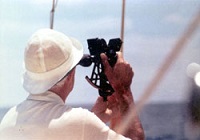 Gus Neely died on Nov. 22, 1985, at the Gulf coast with his 10 m sailboat, The Antares. When he died, his daughter Leigh was a senior at the University of Mississippi School of Medicine. The 1986 school yearbook was dedicated to her father, and she wrote a moving tribute to him, which is framed, on the wall opposite his portrait. Gus left a legacy, the lasting nature of which is testified to by the memories that he created in his colleagues and his students. These memories are embodied in the Gus Neely stories.
Gus Neely died on Nov. 22, 1985, at the Gulf coast with his 10 m sailboat, The Antares. When he died, his daughter Leigh was a senior at the University of Mississippi School of Medicine. The 1986 school yearbook was dedicated to her father, and she wrote a moving tribute to him, which is framed, on the wall opposite his portrait. Gus left a legacy, the lasting nature of which is testified to by the memories that he created in his colleagues and his students. These memories are embodied in the Gus Neely stories.
Memories of Neely
Gus was a fine teacher. He was an accomplished academician. He was a surgeon whom you wanted on your side. But what makes Gus Neely memorable are the stories.
Some of the Gus Neely stories have become so famous that they have names. I have also taken some license to add a few names.
- 'There is a Child in All of Us'
Eric MacDonald described his friend, Gus Neely, as 'the most brilliant 9-year-old whom I ever knew.' - 'Shoe Salesman'
In describing her husband, Anne Neely remarked to me that 'at least I didn't marry a shoe salesman.' - 'Surgical Intuition'
Dan Jones related the following entry by Gus into the medical record of a burned patient: 'Patient burned badly on the front, probably burned badly on the back, don't know, didn't look.' - 'The Right Thing'
John Schimmel's favorite Gus Neely saying was 'A good resident will do the right thing when he doesn't know what the right thing is.' - 'Steam'
Gus Neely's father had a sawmill that was powered by a steam engine. Gus became fascinated with steam engines. He owned two steamboats, and a lot of the Neely lore involves these steamboats. The engine in the first boat came from a World War II British mail boat. He built the second engine himself. Anne told me that 'sometimes we thought that Gus hoped that the steamboat would not work so that he could fix it.' - 'You Have to Sleep Standing'
Gus had an office next to Eric MacDonald's office. For a year, Gus never said anything to Eric. One day, he walked into Eric's office and said, 'How about going out to my steamboat?' They became friends. They worked on steam engines together. Eric painted the memorable portrait. Eric recounted that when Gus was posing for the portrait, he would fall asleep while he was standing. - 'A Surgeon's Daughter'
Leigh Neely was called to the emergency department as a medical student to see a trauma patient who needed a chest tube. The resident said to her, 'Put a chest tube in that patient.' Leigh responded that she had never put in a chest tube. The resident countered 'Well, you're Gus Neely's daughter, aren't you?' - 'Helping Residents'
Jerry Stone from Baton Rouge recalled Gus Neely's admonition that 'exposure is the jewel of surgery.' - 'You Gotta Play Hurt'
Al Meena described the time when Gus was at home recuperating from hepatitis. Al walked into the room, and Gus was reading a book on integral calculus. - 'The Craniobuccal Fistula'
Al Meena described a tendency that Gus had to say exactly what was on his mind. Gus flew some residents to New Orleans to attend the Sugar Bowl. The weather was lousy, and the control tower in New Orleans gave instructions to land on runway C. In an act of pure compassion for the jittery nerves of his passengers, Gus said, 'I wonder which one is runway C?' - 'Infield Chatter'
Swayze Rigby from Baton Rouge remembers Gus' infield chatter during operations. - 'Dissect from the known to the unknown'
- 'Do the easy part first, and the hard part becomes easy'
While dissecting in unknown territory and unsure what structure was about to be cut, Gus' advice was 'cut it; see if it bleeds; if it does we'll know what to do with it.' - 'Doing What is Right'
Bill Garre from Dallas related these scenarios, 'It's 2 a.m. on Sunday morning and Gus is your staff. You present your difficult case that needs immediate surgery in great detail. Gus replies, 'Do whatever you think is right , but be sure that you're right.' It's another evening and another problem. This time the reply is 'If you need me, I'll call you.' - 'Scrub Suits'
Larry Killebrew from Gulfport reported that in the middle of a trauma case, Gus's pants fell off, and that he could not get anyone in the operating room to pull them back up. Gus finished the case with his pants around his ankles. Guys has a lot of trouble with scrub suits. Confronted with no scrub suit shirt in his size, Gus scrubbed on the case without a shirt. Mark Wall told me this morning that Gus fired him twice in one day. One of the occasions involved Mark, then working in the Respiratory Therapy Department of the hospital, taking the last scrub suit. Gus put on a scrub dress, got his residents to put on scrub dresses, and went to the operating room. - 'You Gotta Know Your Anatomy'
There were gems that were overheard in the operating room. After a trauma case, Gus described the situation thusly: 'The vena cava felt like the aorta and the aorta felt like the vena cava. I thought that the patient had situs inversus for a minute.' - 'We Didn't Shoot Him'
While operating on a terminal lung cancer patient Gus remarked, 'Well, we didn't shoot him.' Then after being reminded by the resident that the patient had cancer, Gus retorted, 'Well, we didn't give him that either.' - 'Dr. Hardy'
On any dispute with anyone, Gus ended the discussion with: 'Well, we'll just ask Dr. Hardy about that.' - 'Trouble'
Everyone has their favorite Gus Neely story, and, though I never had the privilege of calling Gus my teacher, colleague or friend, I have my favorite. The story was born when Fred Rushton got up at the end-of-the-year banquet to talk about his experiences as a surgery resident. I could not be more delighted than to have the real-life creator of a Gus Neely story come to the podium to tell us about 'Trouble' and other reminisces. 'I want to thank Harold Conn for teaching me how to stay out of trouble; William Barnett for teaching me how to get out of trouble; Gus Neely for teaching me how to know that I was in trouble; and Dr. Hardy for showing me what real trouble was.'
Farewell
I would like to end with this anonymous comment by one of Gus Neely's residents that sums up the admiration that he invoked.
'The greatest reassurance as a chief on the trauma service was to call Dr. Neely in the middle of the night, describe a trauma case to him, have him respond in his sleep simply, 'OK, OK' and then know that if it was a case which really required his help, he would materialize, almost by magic, because he had heard the same story with the different inflections of each chief resident over the years. Mississippi, and certainly the residents of the university, lost a great man and a great teacher when he died.'
Gus, we may have lost you in body, but not in spirit. As Dr. Hardy reminded us, we owe it to you."


